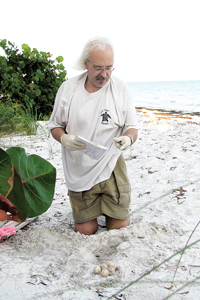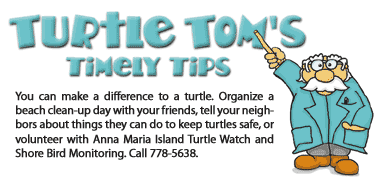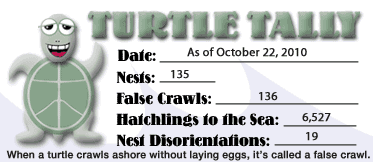Vintage volunteer keen for turtles
From the October 27, 2010 Issue
SUN PHOTO/CINDY LANE
Anna Maria Island Turtle Watch volunteer
John DeFazio excavated a loggerhead sea
turtle nest on the north end of Anna Maria
Island recently, discovering that the eggs
had been underwater so long that they had
drowned. Sea turtle hatchlings need air
to breathe, even before they hatch.
More than 20 years ago, when John DaFazio began volunteering with Anna Maria Island Turtle Watch, it was a common practice to dig up freshly laid sea turtle eggs and take them to a hatchery to incubate.
“We used to use Styrofoam coolers to keep eggs and sand in a shed, and would go spray a little water on them every day or two to keep the sand from getting too hot,” said DeFazio, 67, who started with Turtle Watch in 1989. “They’d hatch and we’d take them that night and release them.
“We also used to raise baby turtles to a year old and feed ‘em chopped up squid,” he recalled. “Regulations have changed quite a bit. It’s more science based now. Now we let them hatch naturally.”
Back then, “People didn’t know as much because turtles hadn’t been studied nearly as long,” said DeFazio, who has served as a Turtle Watch coordinator since 1991. He keeps track of the volunteers who monitor nests on his section of the beach from Pine Avenue to Bean Point.
In other countries, things have not advanced as much, he said, pointing out a recent program in the Nature television series on PBS that showed turtle hatcheries in Cuba, and handlers selling tickets to tourists to set turtle hatchlings free.
“They hatch them in a hatchery like we had at the historical museum. They’re still doing it like we did 20 years ago,” he said.
In his early days as a volunteer, watching a turtle nesting and seeing a turtle nest hatch was a little more exciting than it is two decades later, but DeFazio said he still loves working with animals and nature.
One of his worst days was during a particularly bad storm.
“We tried to get the eggs out of a nest with waves coming in waist deep, and eggs were bobbing in the water,” he said, adding that if eggs are washed out to sea, they will drown. “We were able to save about half of them.”
This season has resulted in the least number of nests ever in his section of beach, he said, partly due to washouts and partly because of fire ants, which eat the eggs.
But overall, the turtle season – which ends on Halloween – has been average, with 135 nests on Anna Maria Island, one more than the 10-year average.
And beginning next season on May 1, DeFazio expects to be back at work, helping ensure the 2011 crop of hatchlings gets to the Gulf.



